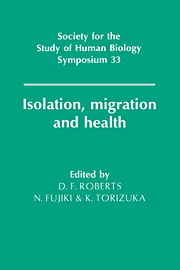Book contents
- Frontmatter
- Contents
- List of contributors
- Preface
- 1 The legacy of the IBP: Presidential Address
- 2 The distinction between primary and secondary isolates
- 3 Time trends in the break-up of isolates
- 4 Factors influencing the frequency of consanguineous marriages in Japan
- 5 Break-up of isolates
- 6 Isolates in India: their origin and characterisation
- 7 Consanguineous marriages and their genetical consequences in some Indian populations
- 8 Biomedical and immunogenetic variation in isolated populations in India
- 9 Genetic distance analyses in Israeli groups using classical markers and DNA polymorphisms in the β globin gene
- 10 Non-random distribution of Gm haplotypes in northern Siberia
- 11 Allele frequency estimation
- 12 Genetic affinities of human populations
- 13 Inherited neurological diseases in island isolates in southern Japan
- 14 Serological and virological evidence for human T-lymphotropic virus type I infection among the isolated Hagahai of Papua New Guinea
- 15 Analysis of genes associated with hypercholesterolaemia in the Japanese population
- 16 Migrant studies and their problems
- 17 Tokelau: migration and health in a small Polynesian society - a longitudinal study
- 18 Micromigrations of isolated Tuareg tribes of the Sahara Desert
- 19 Population structure in the eastern Adriatic: the influence of historical processes, migration patterns, isolation and ecological pressures, and their interaction
- 20 Diabetes and diabetic macroangiopathy in Japanese-Americans
- 21 Diabetes and westernisation in Japanese migrants
- 22 Environmental factors affecting ischemic heart disease
- Epilogue
- Index
6 - Isolates in India: their origin and characterisation
Published online by Cambridge University Press: 05 March 2012
- Frontmatter
- Contents
- List of contributors
- Preface
- 1 The legacy of the IBP: Presidential Address
- 2 The distinction between primary and secondary isolates
- 3 Time trends in the break-up of isolates
- 4 Factors influencing the frequency of consanguineous marriages in Japan
- 5 Break-up of isolates
- 6 Isolates in India: their origin and characterisation
- 7 Consanguineous marriages and their genetical consequences in some Indian populations
- 8 Biomedical and immunogenetic variation in isolated populations in India
- 9 Genetic distance analyses in Israeli groups using classical markers and DNA polymorphisms in the β globin gene
- 10 Non-random distribution of Gm haplotypes in northern Siberia
- 11 Allele frequency estimation
- 12 Genetic affinities of human populations
- 13 Inherited neurological diseases in island isolates in southern Japan
- 14 Serological and virological evidence for human T-lymphotropic virus type I infection among the isolated Hagahai of Papua New Guinea
- 15 Analysis of genes associated with hypercholesterolaemia in the Japanese population
- 16 Migrant studies and their problems
- 17 Tokelau: migration and health in a small Polynesian society - a longitudinal study
- 18 Micromigrations of isolated Tuareg tribes of the Sahara Desert
- 19 Population structure in the eastern Adriatic: the influence of historical processes, migration patterns, isolation and ecological pressures, and their interaction
- 20 Diabetes and diabetic macroangiopathy in Japanese-Americans
- 21 Diabetes and westernisation in Japanese migrants
- 22 Environmental factors affecting ischemic heart disease
- Epilogue
- Index
Summary
The peopling of India
The discovery of lithic and bone tools of the Early Stone Age and subsequent periods from almost all over the country establishes beyond doubt that man has existed for a very long time in India, and the recent discovery of osseous remains of Homo erectus in central India shows the presence there of his antecedents also.
Archaeological and historical evidence further establishes that several waves of immigrants from west and central Asia, and to a lesser extent from north and southeast Asia, came to India during at least the last 10,000 years. The immigrants came primarily by land, but also used sea routes, and mainly settled in the river-valleys and plains. These immigrants brought a variety of cultural as well as biological traits. There is perhaps no other subcontinent in the world that harbours such a rich array of ethnic elements as India. In classical terms all the major races of mankind - Europoid, Mongoloid and Negroid - have contributed in the biological constitution of the people of India (Malhotra, 1978). Numerous anthropometric studies conducted on contemporary Indian populations, and on the prehistoric skeletal remains from different periods and geographical areas, suggest the existence of, or the presence of contributions from, the following ethnic elements among the people of India:
i Negritos (Andaman Islands)
ii Australoids (west, central and southern India)
iii Europoids (all over the country)
iv Mongoloids (north-east and sub-Himalayan region)
v Negroes (west coast and southern India, numbering around 15,000)
- Type
- Chapter
- Information
- Isolation, Migration and Health , pp. 55 - 62Publisher: Cambridge University PressPrint publication year: 1992

